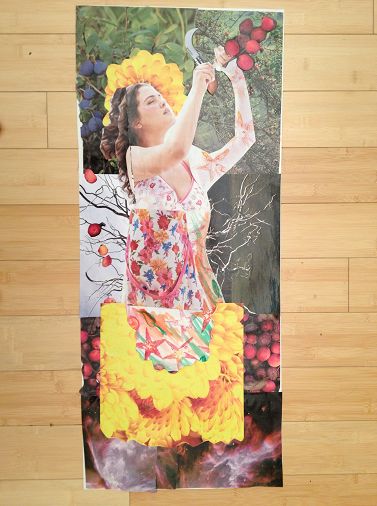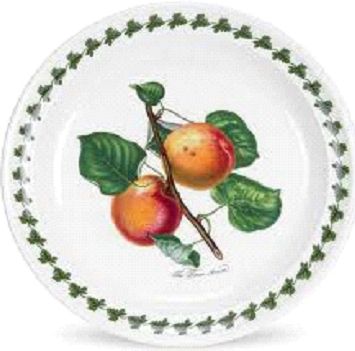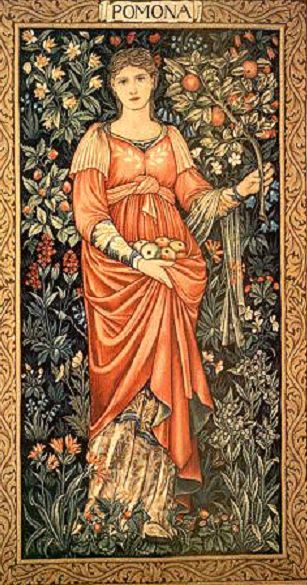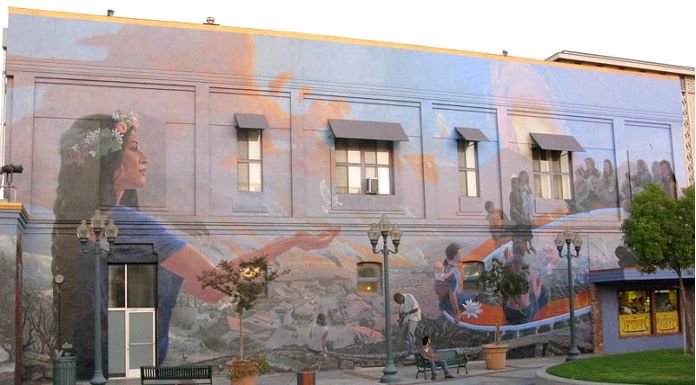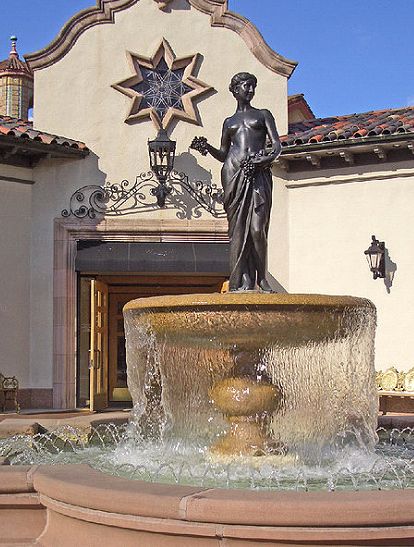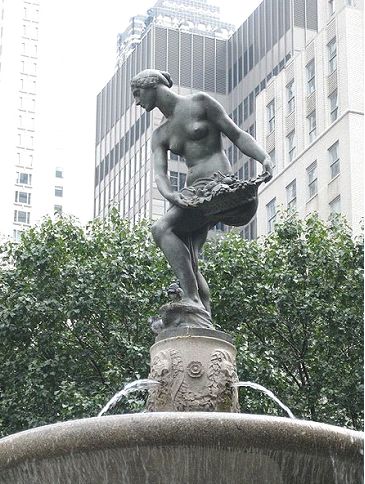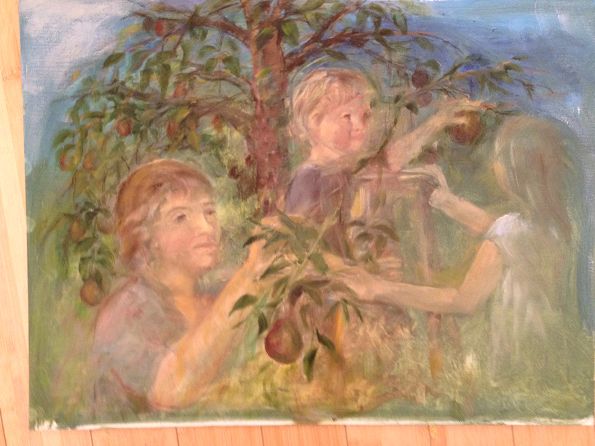The White Moon Goddess Gallery Presents
Encountering Pomona
(The author’s vision of Pomona: collage, watercolor, and apple stamping.)
A Level One Final Project for
The Sacred Three Goddess SchoolBy
Niamh Red Horse
© 2011. All original material in this site is under copyright protection and is the intellectual property of the author.
I’ve had a lifetime of encounters with those beings sacred to Pomona and especially in her care--fruit trees both wild and tame. I lived in Michigan as a child, and my parents bought bushel baskets of Michigan fruit that we children ate freely almost every day. A large part of my flesh is probably built out of apples, so the apple tree and I are sisters under the skin.
Not just the common varieties that are found in stores, either--the Red Delicious, Golden Delicious, McIntosh and Granny Smith--but apples bought from orchards in all their variety: Fuji, Mutsu, Winesap, Ida Red, Northern Spy, Jonathan. I was always on the lookout for wild fruit trees as I roamed around the woods and fields. There’s many a self-seeded wild tree, or a domestic tree gone wild after the woods take back an abandoned farm. As well, there were fruit trees on the edge of neglected property in town, trees offering fruit I could snatch as I whizzed past on my bicycle, and not think it stolen, exactly.
My parents warned me I’d get a tummy-ache from eating green or wind-fallen fruit, but I never did. It was my boast that I could fill my belly with wild, speckled apples, green pears, and sour wild cherries and thrive on them. I sought out communion with wild fruits and offered the tree my silent thanks. I was worshipping Pomona and didn’t know it.
History of Pomona
Pomona is the daughter of Neptune and Ceres. She was one of the twelve Roman gods and goddesses called Numina, who were guardian spirits of Rome, and had their own special priests, called flamen. The Flamen Pomonalis offered worship to Pomona on days that were sacred to her. I have not been able to determine which days those were. There may have been more than one. Some people celebrate her day on August 13, at the same time with the feast of her husband Vertumnus. I have also read that some prefer to celebrate her feast on November 1. This makes more sense for me because the apple harvest is complete by then. The name Pomona comes from the Latin word pomum, meaning fruit. So Pomona is goddess of all types of orchard fruit, but is particularly associated with apples. She was honored in a grove called the Pomonal, near Ostia, the seaport of Rome.
Nothing is known of her rites. She is one of the many goddesses whose worship has faded into obscurity. And yet, she lives on and is honored in many places. I feel she is very much alive even though she goes unrecognized.
The Grange, a farmers’ solidarity organization, gives honorary positions to three women known as Flora, Ceres, and Pomona. I’m sure they don’t believe in her as a goddess, but they are still keeping her name and honor alive.
Portmeirion China makes a line of dishes called “Pomona,” featuring her fruits.
William Morris, a celebrated artist and poet, created a tapestry design featuring Pomona. Edward Burne-Jones designed the figure, and Morris’s studio wove the tapestry.
The design is accompanied by a poem by William Morris in honor of the goddess:
I am the ancient apple-queen,
As once I was so am I now.
For evermore a hope unseen,
Betwixt the blossom and the bough.Ah, where's the river's hidden Gold!
And where the windy grave of Troy?
Yet come I as I came of old,
From out the heart of Summer's joy.The city of Pomona, California, was named for the goddess, and a beautiful mural has been created by artist Judy Chicago, and lead mural artist Kevin Stewart-Magee. Here Pomona is a symbol of the city’s prosperity and hope in a future where humans once again live in harmony with the land.
http://en.wikipedia.org/wiki/Pomona_Envisions_the_Future
There are cities named after Pomona in many states of the U.S., including California, Florida, Illinois, Iowa, Kansas, Maryland, Michigan, Missouri, New Jersey, New York, and Washington. Statues of Pomona appear in many cities across the United States.
Pomona graces the Plaza in Kansas City, Missouri.
Pomona Fountain, by Donatello Gabbrielli, The Plaza, Kansas City, MO
Copyright, Creative Commons, via Wikimedia CommonsShe appears as well in Manhattan’s Grand Army Plaza.
Pomona, atop the Pulitzer Memorial Fountain in the Grand Army Plaza, NYC.
Sculptor Karl Bitter. Copyright, Creative Commons, via Wikimedia CommonsAnd she appears with her fellow goddess, Diana, guarding the Peninsula Hotel on 5th Avenue in New York.
Copyright, Creative Commons, via Wikimedia Commons
http://en.wikipedia.org/wiki/File:DianaAndPomona.jpgAlthough neglected and unsung, Pomona is everywhere!
Pomona’s Gifts
Pomona is represented with a basket or cornucopia of fruits in one hand, and a pruning knife in the other. With her pruning knife, she can help us to trim away whatever is withered or growing in the wrong direction, all that stands in the way of a rich harvest. According to the Roman poet Ovid, she carefully protected and tended her orchard. A well-built wall kept out thieves and predators, and Pomona made sure her plants always had enough water in thirsty times. Pomona can be our helper in tending our boundaries well and protecting what is growing within.
Ovid’s account in his poem, “Metamorphoses,” book 14, is the only surviving description of Pomona from ancient times.
http://www.poetryintranslation.com/PITBR/Latin/Metamorph14.htm#_Toc64108207
He tells the story of how she eventually wed Vertumnus, a god who may have survived from the times of the Etruscans, and whose name is related to the word for changing or turning. Vertumnus is a shape-shifter, and may also symbolize the changing of the seasons. Ovid’s story makes me uncomfortable in some ways. He seems unduly focused on seduction, and on the need for even a female deity to attach herself to a male consort.
I prefer contemporary artist Thalia Took’s charming retelling of the tale, in which Pomona chooses Vertumnus because he has shown himself a worthy partner in her concerns.
Then the light shifted and I saw him clearly—a young man all in green, his body lean and lithe with hard work, his curling hair dark as the new-turned soil in spring, his hands capable and callused and generous, smiling at me with a gentle openness in his face. Well then. He was certainly pretty, and I'll even go so far as to admit I was tempted, but…
Then he asked what variety of apple I was planting in the bed I had turned. How did he know I was planting apples there? Did I think that dates were worth growing this far north, given how difficult it was to winter them over? Had I had any luck with persea-fruit? At that I tossed him a persea-fruit from a basket; then I brought him to my date palms, small but healthy in their sheltered spot on the south side of the wall. He showed me a trick to make sour cherries sweeter; I showed him how to double their yield. We agreed about grafting, argued about pruning, and discussed rootstocks for pears; then he told me of his love for the smell of the warm moist earth and the feel of the soil in his hands, the abiding wonder he felt each time he planted a seed, and the amazement and privilege he experienced in tending to flowering and fruiting life.
Well! Why hadn't he said that in the first place?
http://www.thaliatook.com/AMGG/pomonatale.html
Pomona is a goddess of the liminal, of the fruitful boundary between the wild woods and the cultivated field, and this border between wild and tame is her kingdom. All of us who walk the line between wild exuberance and disciplined growth can look to her for inspiration and wisdom.
A Pomona Ritual
Pomona is an outdoor goddess, so the first portion of this ritual takes place outdoors. Find a fruit tree in your neighborhood. I found a beautiful old apple tree in a park. Ornamental crab apples and cherries count too. Bring a bottle of water to share.
Sit with the tree, ground and center.
Pomona, listen as I call to thee.
Let my roots grow deep as my sister tree.
Send my spirit rain and shine,
Flower and fruit at the perfect time.When you feel yourself well centered, walk around the tree three times, sunward, keeping your hand on the trunk. Pause and offer your wish or intention. Drink from your water, then pour out the rest as a libation for the tree.
For an indoor ritual:
Cut an apple in half to show the star within, and place it on your altar. Place candles at the points of the star: white, pink, green, yellow, and red. Set out a drink made of apples: apple juice, cider, sparkling cider, apple wine or applejack. Set out a treat made with Pomona’s fruit.
Cast your circle. Light the white candle, symbolizing the winter months. Fruit trees need the cold and the fallow season of reflection, or they can’t bear fruit.
Pomona, I seek your protection. Help me create good boundaries to protect my garden. Lend me your pruning knife to trim away all old growth that no longer serves me.
Speak three things that you wish to leave behind.
Light the pink candle, symbolizing the season of blossoming.
Pomona, I seek your delight. Give me joy in each moment of pleasure. May I be renewed in happiness, as the spring blossoms return to the oldest tree.
Speak three things that you wish and desire.
Light the green and yellow candles, symbolizing the summer season when trees are tended and fruit and leaves grow sturdy and strong.
Pomona, I seek your diligence and your steady hand. Let me work at your side to tend my spirit and manifest my harvest.
Speak three goals you will work for and accomplish.
Light the red candle, symbolizing the richness of the harvest and the ripe fruit.
Pomona, I seek your harvest in my heart. I give thanks for all the good that has come to me and for all the great deeds I have already accomplished.
Speak three things you are grateful for or proud of.
Meditate on any thoughts that have come to you.
In rest, hope, work and harvest, Pomona, be with me.
In leaf and fruit and flower may I flourish like a tree.
May I live in your abundance, Pomona, blessed be.Open the circle. Let the candles burn out (safely!) Partake of the blessed drink and food, setting aside a portion to take outside and leave under a tree for the wild creatures.
Pomona-Honoring Recipes
Millie Schembechler’s Apple Cake
1 c. cooking oil
2 c. sugar
3 eggs
2 1/2 c. sifted flour
1 t. baking soda
1 t. vanilla
(I like to add a teaspoon of nutmeg or cinnamon)
3 c. coarsely chopped unpeeled apples
1 c. chopped pecans or walnutsCream the cooking oil, sugar and eggs.
Add and stir in flour, soda, and spices.
Add and stir in flavoring, apples, and pecans.Bake in a tube pan for an hour at 350 degrees, or until the top is light brown.
This recipe can also be made in cupcake pans, and the cooking time reduced accordingly. Different fruit can be substituted. I made the recipe with peaches and strawberries, and it was good. Pears work too.
Apple Crisp
2 pounds of cooking apples, peeled and sliced (5 1/2 cups)
(I usually don’t measure--I just pile in apples till there’s a nice mound in my pie plate)
1/4 c. water (I sometimes leave the water out, especially if I’m using a very juicy kind of apple)
1/2 c. granulated sugar
1/2 c. firmly packed brown sugar
1/2 t. each of ground nutmeg and cinnamon (I like cinnamon, so I sometimes put in a whole tsp. of cinnamon)
1/4 t. salt
3/4 c. flour
1/2 c. butterPut apples in a shallow 2-quart casserole (I usually use a pie plate); add water.
Combine sugars, nutmeg, cinnamon, salt and flour. Cut butter into the mixture with pastry blender. (Or you can use your KitchenAid mixer on low speed until the butter is evenly mixed in small lumps the size of peas.) Spread over the top of the apple mixture.Cover and bake in 350 degree oven for 30 minutes. Uncover and bake for 30 minutes longer.
This is very delicious with vanilla ice cream.
Apple Nut Loaf (from the Tassajara Bread Book)
http://tinyurl.com/bwycdrgMakes 2 large loaves
2 T yeast
1/2 c. sweet cider (lukewarm)
1 c honey
1/2 c. oil
4 beaten eggs
1/2 t. salt
2 t. vanilla extract
2 T. finely chopped orange peel (I usually just grate it)
4 c. whole wheat flour
4 c. raw apples with skins, grated
1 c. nuts, coarsely choppedOptional:
1 T cinnamon
1 t allspice
1 t nutmeg
1/2 c. coconut
1/2 c. dates or raisinsSoften yeast in cider. Blend honey, oil, eggs, salt and flavorings. Add yeast mixture. Stir in remaining ingredients. Turn into oiled loaf pans. Let rise one hour. Bake at 350 to 375 for 40-60 minutes. (Time and temperature are approximate, so you just have to check it until the top is nice and springy and it seems done.)
I close with a painting by my mother. She called it “Picking Pears,” but I call it “Pomona and Her Children.” It was based on me, my daughter, and my grandson.
Used by permission of the artist.
Return to Goddess Gallery
